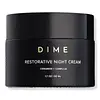What's inside
What's inside
 Key Ingredients
Key Ingredients

 Benefits
Benefits

 Concerns
Concerns

 Ingredients Side-by-side
Ingredients Side-by-side

Water
Skin ConditioningOctyldodecyl Neopentanoate
EmollientDicaprylyl Carbonate
EmollientGlycerin
HumectantBehenyl Alcohol
EmollientGlycine Soja Seed Extract
Skin ConditioningMangifera Indica Seed Butter
Skin ConditioningGlyceryl Stearate
EmollientCandelilla/Jojoba/Rice Bran Polyglyceryl-3 Esters
EmulsifyingVinyl Dimethicone/Methicone Silsesquioxane Crosspolymer
Potassium Cetyl Phosphate
EmulsifyingNiacinamide
SmoothingPhenoxyethanol
PreservativeSodium Stearoyl Lactylate
EmulsifyingCetearyl Alcohol
EmollientMicrocrystalline Cellulose
AbsorbentCaprylyl Glycol
EmollientParfum
MaskingMagnesium Aluminum Silicate
AbsorbentChlorphenesin
AntimicrobialCetyl Hydroxyethylcellulose
Emulsion StabilisingDisodium EDTA
Tocopheryl Acetate
AntioxidantSodium PCA
HumectantUrea
BufferingEthylhexylglycerin
Skin ConditioningCellulose Gum
Emulsion StabilisingGlyceryl Acrylate/Acrylic Acid Copolymer
HumectantTrehalose
HumectantHexylene Glycol
EmulsifyingPolyquaternium-51
Skin ConditioningTriacetin
AntimicrobialSodium Hyaluronate
HumectantTitanium Dioxide
Cosmetic ColorantWater, Octyldodecyl Neopentanoate, Dicaprylyl Carbonate, Glycerin, Behenyl Alcohol, Glycine Soja Seed Extract, Mangifera Indica Seed Butter, Glyceryl Stearate, Candelilla/Jojoba/Rice Bran Polyglyceryl-3 Esters, Vinyl Dimethicone/Methicone Silsesquioxane Crosspolymer, Potassium Cetyl Phosphate, Niacinamide, Phenoxyethanol, Sodium Stearoyl Lactylate, Cetearyl Alcohol, Microcrystalline Cellulose, Caprylyl Glycol, Parfum, Magnesium Aluminum Silicate, Chlorphenesin, Cetyl Hydroxyethylcellulose, Disodium EDTA, Tocopheryl Acetate, Sodium PCA, Urea, Ethylhexylglycerin, Cellulose Gum, Glyceryl Acrylate/Acrylic Acid Copolymer, Trehalose, Hexylene Glycol, Polyquaternium-51, Triacetin, Sodium Hyaluronate, Titanium Dioxide
Water
Skin ConditioningGlycerin
HumectantCetearyl Alcohol
EmollientEthylhexyl Olivate
Skin ConditioningIsononyl Isononanoate
EmollientGlyceryl Stearate
EmollientPentylene Glycol
Skin Conditioning1,2-Hexanediol
Skin ConditioningBehenyl Alcohol
EmollientSimmondsia Chinensis Seed Oil
EmollientSqualane
EmollientSodium Stearoyl Lactylate
EmulsifyingHydroxyacetophenone
AntioxidantCaprylic/Capric Triglyceride
MaskingButyrospermum Parkii Butter
Skin ConditioningCarbomer
Emulsion StabilisingXanthan Gum
EmulsifyingCamellia Oleifera Seed Oil
Skin ConditioningOlea Europaea Fruit Unsaponifiables
AntioxidantStearyl Glycyrrhetinate
Skin ConditioningTetrasodium Glutamate Diacetate
Linoleic Acid
CleansingPhospholipids
Skin ConditioningPhytosterols
Skin ConditioningCeramide NP
Skin ConditioningHydroxypropyl Cyclodextrin
MaskingSodium Hyaluronate
HumectantGlycolipids
Skin ConditioningGlycine Max Seed Extract
Skin ConditioningAloe Barbadensis Leaf Juice
Skin ConditioningHippophae Rhamnoides Fruit Oil
Skin ProtectingPalmitoyl Tripeptide-38
Skin ConditioningWater, Glycerin, Cetearyl Alcohol, Ethylhexyl Olivate, Isononyl Isononanoate, Glyceryl Stearate, Pentylene Glycol, 1,2-Hexanediol, Behenyl Alcohol, Simmondsia Chinensis Seed Oil, Squalane, Sodium Stearoyl Lactylate, Hydroxyacetophenone, Caprylic/Capric Triglyceride, Butyrospermum Parkii Butter, Carbomer, Xanthan Gum, Camellia Oleifera Seed Oil, Olea Europaea Fruit Unsaponifiables, Stearyl Glycyrrhetinate, Tetrasodium Glutamate Diacetate, Linoleic Acid, Phospholipids, Phytosterols, Ceramide NP, Hydroxypropyl Cyclodextrin, Sodium Hyaluronate, Glycolipids, Glycine Max Seed Extract, Aloe Barbadensis Leaf Juice, Hippophae Rhamnoides Fruit Oil, Palmitoyl Tripeptide-38
Ingredients Explained
These ingredients are found in both products.
Ingredients higher up in an ingredient list are typically present in a larger amount.
Behenyl Alcohol is a type of fatty alcohol (these are different from the drying, solvent alcohols).
Fatty Alcohols have hydrating properties and are most often used as an emollient or to thicken a product. They are usually derived from natural fats and oils; behenyl alcohol is derived from the fats of vegetable oils.
Emollients help keep your skin soft and hydrated by creating a film that traps moisture in.
In 2000, Behenyl Alcohol was approved by the US as medicine to reduce the duration of cold sores.
Learn more about Behenyl AlcoholCetearyl alcohol is a mixture of two fatty alcohols: cetyl alcohol and stearyl alcohol. It is mainly used as an emulsifier. Emulsifiers help prevent the separation of oils and products. Due to its composition, it can also be used to thicken a product or help create foam.
Cetearyl alcohol is an emollient. Emollients help soothe and hydrate the skin by trapping moisture.
Studies show Cetearyl alcohol is non-toxic and non-irritating. The FDA allows products labeled "alcohol-free" to have fatty alcohols.
This ingredient is usually derived from plant oils such as palm, vegetable, or coconut oils. There is debate on whether this ingredient will cause acne.
Due to the fatty acid base, this ingredient may not be Malassezia folliculitis safe.
Learn more about Cetearyl AlcoholGlycerin is already naturally found in your skin. It helps moisturize and protect your skin.
A study from 2016 found glycerin to be more effective as a humectant than AHAs and hyaluronic acid.
As a humectant, it helps the skin stay hydrated by pulling moisture to your skin. The low molecular weight of glycerin allows it to pull moisture into the deeper layers of your skin.
Hydrated skin improves your skin barrier; Your skin barrier helps protect against irritants and bacteria.
Glycerin has also been found to have antimicrobial and antiviral properties. Due to these properties, glycerin is often used in wound and burn treatments.
In cosmetics, glycerin is usually derived from plants such as soybean or palm. However, it can also be sourced from animals, such as tallow or animal fat.
This ingredient is organic, colorless, odorless, and non-toxic.
Glycerin is the name for this ingredient in American English. British English uses Glycerol/Glycerine.
Learn more about GlycerinGlyceryl Stearate is a mix of glycerin and stearic acid.
It is used to stabilize the mixing of water and oil ingredients. By preventing these ingredients from separating, it can help elongate shelf life. It can also help thicken the product's texture.
As an emollient, it helps soften skin and supports barrier-replenishing ingredients.
In cosmetics, Glyceryl Stearate is often made from vegetable oils or synthetically produced.
This ingredient may not be fungal-acne safe
Fun fact: The human body also creates Glyceryl Stearate naturally.
Learn more about Glyceryl StearateSodium Hyaluronate is hyaluronic acid's salt form. It is commonly derived from the sodium salt of hyaluronic acid.
Like hyaluronic acid, it is great at holding water and acts as a humectant. This makes it a great skin hydrating ingredient.
Sodium Hyaluronate is naturally occurring in our bodies and is mostly found in eye fluid and joints.
These are some other common types of Hyaluronic Acid:
Learn more about Sodium HyaluronateThis ingredient also goes by the name SSL. It is a non-toxic, biodegradable ingredient made from renewable sources.
SSL is typically used as a surfactant and emulsifier in skincare to stabilize water-based formulas and improve texture. It can be synthetic or animal-derived.
Water. It's the most common cosmetic ingredient of all. You'll usually see it at the top of ingredient lists, meaning that it makes up the largest part of the product.
So why is it so popular? Water most often acts as a solvent - this means that it helps dissolve other ingredients into the formulation.
You'll also recognize water as that liquid we all need to stay alive. If you see this, drink a glass of water. Stay hydrated!
Learn more about Water